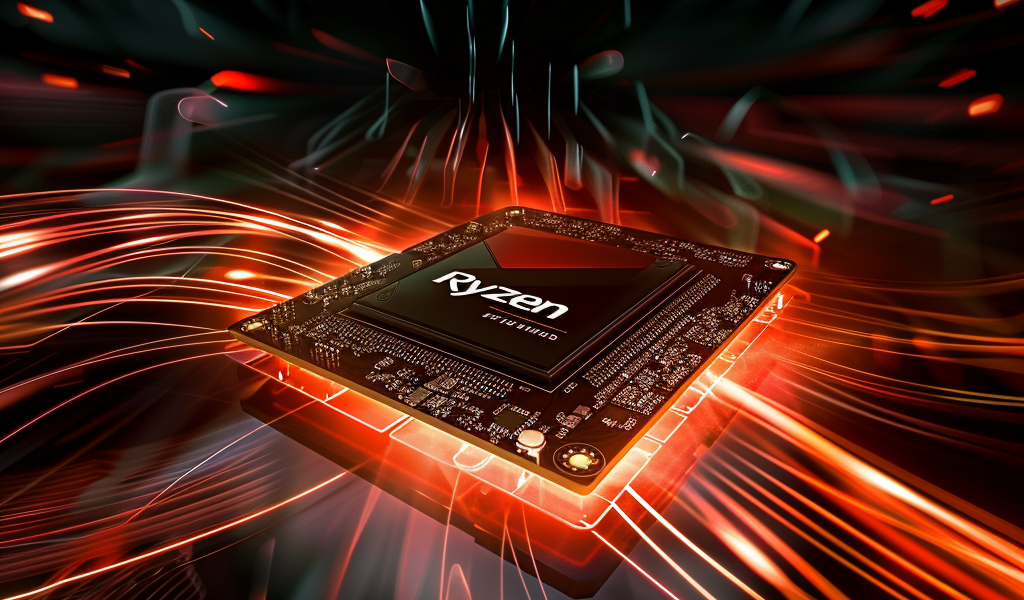AMD is making waves in the tech community once again with the recent leak of its upcoming high-end Strix Halo “Ryzen” APUs. This new lineup is poised to elevate laptop performance significantly, featuring cutting-edge specifications that cater to both gamers and professionals alike.
The Strix Halo APUs were recently spotted in the Geekbench 5 database, revealing an engineering sample (ES) that showcases impressive capabilities. The highlighted APU boasts 8 cores and can reach clock speeds of up to 5.36 GHz, suggesting a powerful performance upgrade over previous models.
Key Specifications of the AMD Strix Halo APUs
The AMD Strix Halo APUs are expected to feature:
- Zen 5 chiplet architecture
- Up to 16 cores
- 64 MB of shared L3 cache
- 40 RDNA 3.5 Compute Units
- 32 MB of MALL cache for integrated graphics
- 256-bit LPDDR5X-8000 memory controller
- XDNA 2 engine for enhanced AI capabilities
- Up to 60 AI TOPS (Tera Operations Per Second)
- 16 PCIe Gen4 lanes
- Expected launch in the second half of 2024
- FP11 platform with a thermal design power (TDP) range of 55W to 130W
This upcoming APU lineup is particularly noteworthy as it aims to push the limits of what mobile processors can achieve, particularly in the realm of gaming and high-performance computing.
Performance Insights
The leaked APU, identified with the OPN ID “100-000001422-31_N”, demonstrated clock speeds ranging from 3.4 GHz to 4.8 GHz during testing. Although it did not consistently reach the maximum boost clock of 5.36 GHz, this engineering sample provides a glimpse into the potential capabilities of the final retail versions.
For comparison, the current Ryzen AI 300 series chips max out at 5.1 GHz. The Strix Halo’s higher clock speed indicates that users can expect even greater performance, possibly reaching clock speeds of 5.4 GHz to 5.5 GHz in practical applications.
Enhanced Cache and Memory Configurations
In terms of cache architecture, the Strix Halo APUs are designed with 32 MB of L3 cache and 8 MB of L2 cache, allowing for improved data retrieval speeds and overall performance. Each Zen 5 core will feature 4 MB of L3 and 1 MB of L2 cache, enhancing the efficiency of the processing tasks.
The chiplet configuration allows for a maximum of 16 cores and 32 threads, with the potential for up to 64 MB of L3 cache. Additionally, the integrated RDNA 3.5 graphics will benefit from 32 MB of MALL cache, providing a solid foundation for gaming and graphical applications.
Memory and Connectivity Features
The AMD Strix Halo APUs are expected to support configurations of up to 128 GB of memory on the FP11 platform, ensuring that users can take full advantage of the processing power available. This is particularly beneficial for users engaged in memory-intensive tasks such as video editing, 3D rendering, and high-end gaming.
Furthermore, the inclusion of 16 PCIe Gen4 lanes enhances connectivity options, allowing for faster data transfer rates and improved performance when utilizing high-speed storage solutions and graphics cards.
Market Impact and Expectations
As AMD continues to innovate with its Ryzen lineup, the Strix Halo APUs are set to compete in a market that is increasingly focused on performance and efficiency. The growing demand for powerful mobile processors, particularly in the gaming and AI sectors, positions AMD favorably as it prepares to launch its latest offerings.
With the anticipated release of the Strix Halo APUs in late 2024, AMD aims to solidify its presence in the high-performance laptop market, appealing to both gamers seeking top-tier performance and professionals requiring robust computing capabilities.
As the tech community awaits further details and official announcements from AMD, the excitement surrounding the Strix Halo APUs continues to build, promising a new era of mobile computing.





